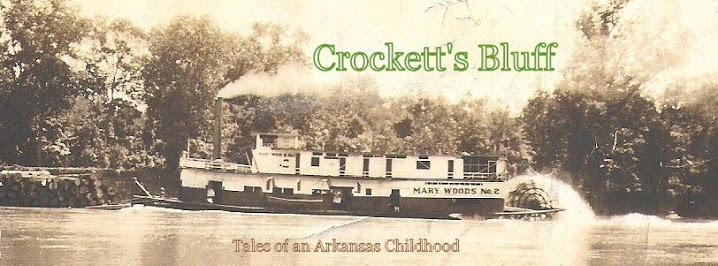[A second selection of excerpts from David B. Prange's Crockett's Bluff As I Remember It.]
"There also was a two-room school that taught grades one through eight. Kindergarten was unheard of in those days, at least in and around Crockett's Bluff. There was a large wood framed grain storage building which was owned by the Prange brothers, a small wood framed church building which served the Lutheran Denomination, a blacksmith shop owned and operated by Mr. Schwab, a cemetery, and a large steam powered relift which was owned by August Prange Sr. This relift lifted water from the [White] river to irrigate the rice fields of the White River Prairie. There were approximately forty permanent dwellings. Estimating the number of homes is made difficult because of the looseness of the village boundaries. There were an additional four or five homes floating on the river. An elevated water storage tank was prominent within the village.
I have fond memories of that tank. It was supported by a steel framework about one hundred feet above grade. It served only for water storage but was a major landmark for travelers because it could be seen for miles around, projecting above the surrounding trees.
. . . . As I mentioned earlier, the schoolhouse was comprised of two rooms. The one room, which was referred to as the "lower room" housed grade one through four The other room, referred to as the "upper room" housed grades five through eight. A school day was from nine o'clock until four. We were given fifteen-minuted recesses, one during the morning hours and one during the afternoon. Our lunch period was for one hour.
During the winter months, our school was heated, utilizing a wood burning stove, one in each room. The stove wood was from a huge pile located near and west of the building. I thought then that this wood must have appeared by magic. I never once witnessed anyone hauling it there. Even now, I wonder who cut and delivered it. It had to have been no small task. Our drinking water was from a hand-powered pump.
. . . . I enjoyed my school days. I looked forward with joyful anticipation to the ending of summer break -- well, more or less.
The advantage we had over the way teaching is accomplished today was that all of us students, in a literal sense, attended all of the classes of all the grades within the room. How this occurred was that each class was conducted in the open room in the presence of all the other grades. A long bench was situated in front of the teacher's desk. When it came time for a specific class, the teacher would call forth the children of that class to sit on the bench. The rest of the grades could watch and hear as the lesson proceeded thereby, we actually attended all the classes. I do believe that this phenomenon was the cause for the children of Crockett's Bluff being known for their brilliance. I think that is what they were known for.
. . . . As I look back, way back, to my days at St. Charles High, it was primitive in relation to other contemporary high schools. Our school may have been small and backwoods, but, make no mistake, I would have have had it any other way. Yes, we had no running water, necessitating an outdoor privy, and our only heat was from a wood-burning stove. We may have been short on funding, but as I learned later, we matched other schools in academics. In fact, upon entering Alexander Hamilton High School in Los Angeles, California to finish the last half of my senior year, in 1944, I was so far ahead of my fellow students, academically, that the authorities found it difficult to place me. In my homeroom, I was referred to as the brainchild. Not because I was so brilliant, but that I had already had it all. Thanks to St. Charles High.
The school building . . . is gone forever, but my memories of those wonderful days will live until I am no longer here.

